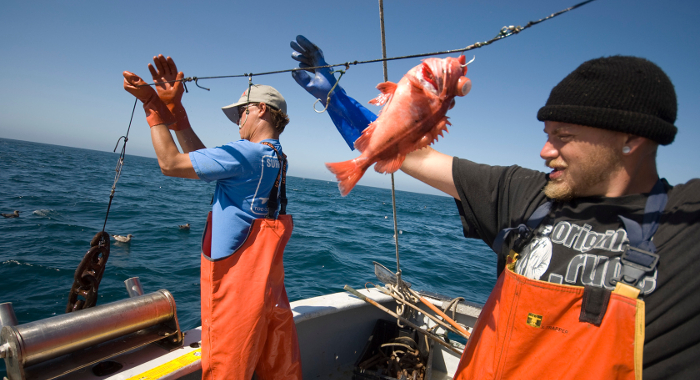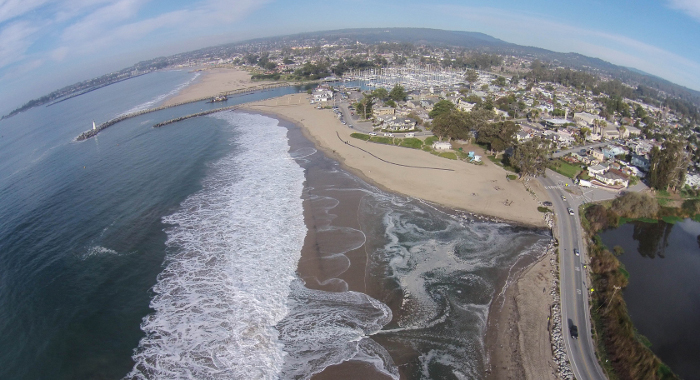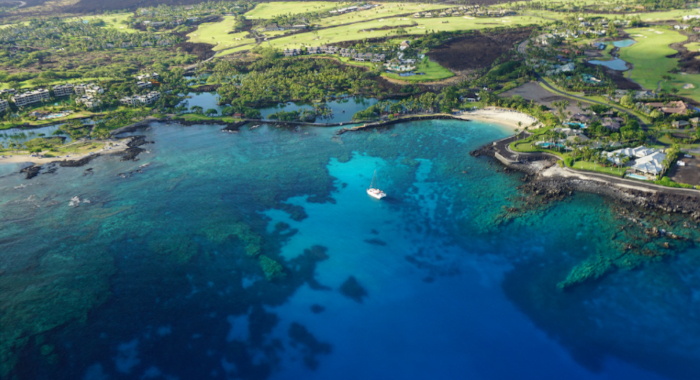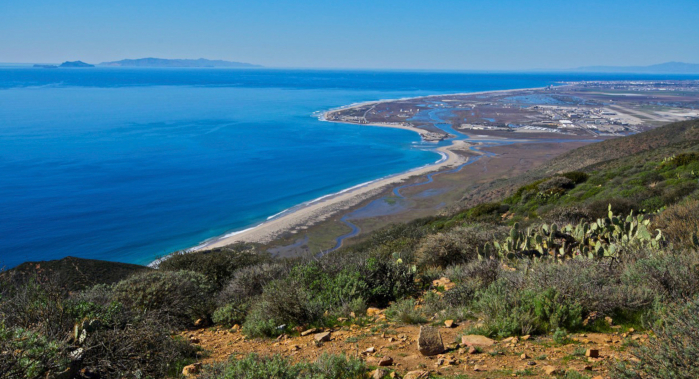The California Current is one of only four temperate upwelling systems in the world. Seasonal upwelling of nutrient-rich waters fuels a highly productive ecosystem, supporting biodiversity and fisheries that, along with coastal tourism, are a foundation of California’s economy.
Yet California’s coasts and oceans are also under increasing threat. Relatively few fisheries are managed based on robust scientific assessments, and more needs to be done to avoid overfishing and reduce bycatch. Plastics and other pollutants are pervasive. Climate change compounds these challenges. Ocean chemistry is changing. Sea levels and temperatures are rising – threatening important resources, biodiversity, and human populations.
Fortunately, the coastal and ocean ecosystems of California are bolstered by a network of marine protected areas and some of the most science-based marine policies in the world. Conservancy scientists look to build on those foundations by applying science and technology to enhance resilience of marine resources in the face of emerging threats.




Heather Tallis, Katharine Kreis, Lydia Olander, Claudia Ringler, David Ameyaw, Mark E Borsuk, Diana Fletschner, Edward Game,, Daniel O Gilligan, Marc Jeuland, Gina Kennedy, Yuta J Masuda, Sumi Mehta, Nicholas Miller, Megan Parker, Carmel Pollino, Julie Rajaratnam, David Wilkie, Wei Zhang, Selena Ahmed, Oluyede C Ajayi, Harold Alderman, George Arhonditsis, Ines Azevedo, Ruchi Badola, Rob Bailis, Patricia Balvanera, Emily Barbour, Mark Bardini, David N Barton, Jill Baumgartner, Tim G Benton, Emily Bobrow, Deborah Bossio, Ann Bostrom, Ademola Braimoh, Eduardo Brondizio, Joe Brown, Benjamin P Bryant, Ryan SD Calder, Becky Chaplin-Kramer, Alison Cullen, Nicole DeMello, Katherine L Dickinson, Kristie L Ebi, Heather E Eves, Jessica Fanzo, Paul J Ferraro, Brendan Fisher, Edward A Frongillo, Gillian Galford, Dennis Garrity, Lydiah Gatere, Andrew P Grieshop, Nicola J Grigg, Craig Groves, Mary Kay Gugerty, Michael Hamm, Xiaoyue Hou, Cindy Huang, Marc Imhoff, Darby Jack, Andrew D Jones, Rodd Kelsey, Monica Kothari, Ritesh Kumar, Carl Lachat, Ashley Larsen, Mark Lawrence, Fabrice DeClerck, Phillip S Levin, Edward Mabaya, Jacqueline MacDonald Gibson, Robert I McDonald, Georgina Mace, Ricardo Maertens, Dorothy I Mangale, Robin Martino, Sara Mason, Lyla Mehta, Ruth Meinzen-Dick, Barbara Merz, Siwa Msangi, Grant Murray, Kris A Murray, Celeste E Naude, Nathaniel K Newlands, Ephraim Nkonya, Amber Peterman, Tricia Petruney, Hugh Possingham, Jyotsna Puri, Roseline Remans, Lisa Remlinger, Taylor H Ricketts, Bedilu Reta, Brian E Robinson, Dilys Roe, Joshua Rosenthal, Guofeng Shen, Drew Shindell, Ben Stewart-Koster, Terry Sunderland, William J Sutherland, Josh Tewksbury, Heather Wasser, Stephanie Wear, Chris Webb, Dale Whittington, Marit Wilkerson, Heidi Wittmer, Benjamin DK Wood, Stephen Wood,, Joyce Wu, Gautam Yadama and Stephanie Zobrist
Although environmental conservation, human health, and sustainable development challenges are interconnected, approaches to these challenges and the evidence used remain disconnected. Creating…Sean P. Fitzgerald , Hunter S. Lenihan, Jono R. Wilson, Carolynn S. Culver, Matthew Potoski
This paper highlights the benefits of collaborative fisheries research in the management of wild capture fisheries. The authors teamed up with commercial fishermen in the southern California…Laura S. Brophy, Correigh M. Greene, Van C. Hare, Brett Holycross, Andy Lanier, Walter N. Heady, Kevin O’Connor, Hiroo Imaki, Tanya Haddad, Randy Dana
The authors of this study generated new maps of current and historical tidal wetlands in 450 estuaries throughout Washington, Oregon, and California. Using laser-mapping technology known as LIDAR…Matt Merrifield, Mary Gleason, Lyall Bellquist, Kate Kauer, Dwayne Oberhoff, Chad Burt, Steve Reinecke, Michael Bella
In 2006, The Nature Conservancy of California purchased 13 federal groundfish permits in California with the objective of managing the fishing and reporting activities in a manner that protected…Kate Kauer
Holmes ND, Spatz DR, Oppel S, Tershy B, Croll DA, et al.
Restoring islands by eradicating damaging, non-native invasive mammals such as rats, cats, goats, and pigs has repeatedly proven to be a high impact conservation action. New research…Rodríguez A, Arcos JM, Bretagnolle V, Dias MP, Holmes ND, Louzao M, Provencher J, Raine AF, Ramírez F, Rodríguez B, Ronconi RA, Taylor RS, Bonnaud E, Borrelle SB, Cortés V, Descamps S, Friesen VL, Genovart M, Hedd A, Hodum P, Humphries G, Le Corre M, Lebarbenchon C, Martin R, Melvin EF, Montevecchi WA, Pinet P, Pollet IL, Ramos R, Russell JC, Ryan PG, Sanz-Aguilar A, Spatz DR, Travers M, Votier SC, Wanless RM, Woehler E, Chiaradia A
Seabirds are amongst the most engaged species on our planet. Among these are petrels and shearwaters: species characterized by long ocean journeys for migration and feeding, and a dependence on…Darcy Bradley, Matt Merrifield, Karly M. Miller, Serena Lomonico, Jono R. Wilson, Mary G. Gleason
A lack of fishery data leads to uncertainty about stock status, which may compromise and threaten the economic and food security of the users dependent upon that stock and increase the…William J. Harford, Natalie A. Dowling, Jeremy D. Prince, Frank Hurd, Lyall Bellquist, Jack Likins, Jono R. Wilson
Among abalone species that were once harvested along the California coastline, red abalone (Haliotis rufescens) supports the remaining recreational fishery. To support development of a red abalone…Nicholas D. Holmes, Olivier Langrand, Russell A. Mittermeier, Anthony B. Rylands, Thomas Brooks, Dena R. Spatz, James C. Russell, Wes Sechrest, Federico Méndez Sánchez, Cristina Mittermeier (Editor)
Covering only five percent of the land on our planet, islands are home to an estimated 20 percent of the world’s bird, reptile, and plant species, as well as the most astonishing examples of…Randall, J.M., K. McEachern, J. Knapp, P. Power, S. Junak, K. Gill, D. Knapp, M. Guilliams
Kate Kauer, Lyall Bellquist, Mary Gleason, Aliya Rubinstein, Joe Sullivan, Dwayne Oberhoff, Lisa Damrosch, Michelle Norvell, Michael Bell
This paper presents how voluntary collective agreements amongst fishermen can be used to reduce risk of bycatch of sensitive species and improve fishery performance in the West Coast groundfish…Sean P. Fitzgerald, Jono R. Wilson , Hunter S. Lenihan
Despite the economic value of California fisheries, many lack information needed to determine if fishing is occurring at a sustainable level. The Southern California Rock Crab fishery in the Santa…Holmes ND, Keitt BS, Spatz DR, Will DJ, Hein S, Russell JC, Genovesi P, Cowan PE, Tershy BR
Indicators for tracking conservation efforts at a global scale are rare but important tools for understanding trends and measuring progress towards global conservation targets. Eradication of invasive…